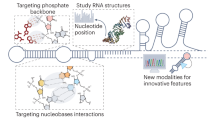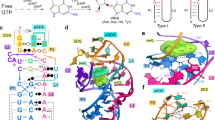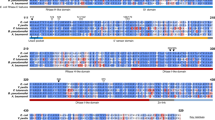Abstract
New validated cellular targets are needed to reinvigorate antibacterial drug discovery. This need could potentially be filled by riboswitches—messenger RNA (mRNA) structures that regulate gene expression in bacteria. Riboswitches are unique among RNAs that serve as drug targets in that they have evolved to form structured and highly selective receptors for small drug-like metabolites. In most cases, metabolite binding to the receptor represses the expression of the gene(s) encoded by the mRNA. If a new metabolite analog were designed that binds to the receptor, the gene(s) regulated by that riboswitch could be repressed, with a potentially lethal effect to the bacteria. Recent work suggests that certain antibacterial compounds discovered decades ago function at least in part by targeting riboswitches. Herein we will summarize the experiments validating riboswitches as drug targets, describe the existing technology for riboswitch drug discovery and discuss the challenges that may face riboswitch drug discoverers.
This is a preview of subscription content, access via your institution
Access options
Subscribe to this journal
Receive 12 print issues and online access
$209.00 per year
only $17.42 per issue
Buy this article
- Purchase on Springer Link
- Instant access to full article PDF
Prices may be subject to local taxes which are calculated during checkout




Similar content being viewed by others
References
Theuretzbacher, U. & Toney, J.H. Nature's clarion call of antibacterial resistance: are we listening? Curr. Opin. Investig. Drugs 7, 158–166 (2006).
D'Costa, V.M., McGrann, K.M., Hughes, D.W. & Wright, G.D. Sampling the antibiotic resistome. Science 311, 374–377 (2006).
Mandal, M. & Breaker, R.R. Gene regulation by riboswitches. Nat. Rev. Mol. Cell Biol. 5, 451–463 (2004).
Tucker, B.J. & Breaker, R.R. Riboswitches as versatile gene control elements. Curr. Opin. Struct. Biol. 15, 342–348 (2005).
Winkler, W.C. & Breaker, R.R. Regulation of bacterial gene expression by riboswitches. Annu. Rev. Microbiol. 59, 487–517 (2005).
Winkler, W., Nahvi, A. & Breaker, R.R. Thiamine derivatives bind messenger RNAs directly to regulate bacterial gene expression. Nature 419, 952–956 (2002).
Rodionov, D.A., Vitreschak, A.G., Mironov, A.A. & Gelfand, M.S. Comparative genomics of thiamin biosynthesis in procaryotes. New genes and regulatory mechanisms. J. Biol. Chem. 277, 48949–48959 (2002).
Sudarsan, N., Barrick, J.E. & Breaker, R.R. Metabolite-binding RNA domains are present in the genes of eukaryotes. RNA 9, 644–647 (2003).
Sudarsan, N., Cohen-Chalamish, S., Nakamura, S., Emilsson G.M. & Breaker, R.R. Thiamine pyrophosphate riboswitches are targets for the antimicrobial compound pyrithiamine. Chem. Biol. 12, 1325–1335 (2005).
Zhang, R., Ou, H.-Y. & Zhang, C.-T. DEG, a database of essential genes. Nucleic Acids Res. 32, D271–D272 (2004).
Forsyth, R.A. et al. A genome-wide strategy for the identification of essential genes in Staphylococcus aureus. Mol. Microbiol. 43, 1387–1400 (2002).
Dunman, P.M. et al. Transcription profiling-based identification of Staphylococcus aureus genes regulated by the agr and/or sarA loci. J. Bacteriol. 183, 7341–7353 (2001).
Epshtein, V., Mironov, A.S. & Nudler, E. The riboswitch-mediated control of sulfur metabolism in bacteria. Proc. Natl. Acad. Sci. USA 100, 5052–5056 (2003).
Murphy, B.A., Grundy, F.J. & Henkin, T.M. Prediction of gene function in methylthioadenosine recycling from regulatory signals. J. Bacteriol. 184, 2314–2318 (2002).
Winkler, W.C., Nahvi, A., Sudarsan, N., Barrick, J.E. & Breaker, R.R. An mRNA structure that controls gene expression by binding S-adenosylmethionine. Nat. Struct. Biol. 10, 701–707 (2003).
Nahvi, A., Barrick, J.E. & Breaker, R.R. Coenzyme B12 riboswitches are widespread genetic control elements in prokaryotes. Nucleic Acids Res. 32, 143–150 (2004).
Monaghan, R.L. & Barrett, J.F. Antibacterial drug discovery-then, now and the genomics future. Biochem. Pharmacol. 71, 901–909 (2006).
Knowles, D.J., Foloppe, N., Matassova, N.B. & Murchie, A.I. The bacterial ribosome, a promising focus for structure-based drug design. Curr. Opin. Pharmacol. 2, 501–506 (2002).
Steitz, T.A. On the structural basis of peptide-bond formation and antibiotic resistance from atomic structures of the large ribosomal subunit. FEBS Lett. 579, 955–958 (2005).
Zaman, G.J.R. & Michiels, P.J.A. Targeting RNA with small molecule drugs in Trends in RNA Research (ed. McNamara, P.) 1–21 (Nova Science Publishers, Inc., Hauppauge, NY, 2006).
Hermann, T. & Tor, Y. RNA as a target for small-molecule therapeutics. Expert. Opin. Ther. Pat. 15, 49–62 (2005).
Mandal, M., Boese, B., Barrick, J.E., Winkler, W.C. & Breaker, R.R. Riboswitches control fundamental biochemical pathways in Bacillus subtilis and other bacteria. Cell 113, 577–586 (2003).
Serganov, A. et al. Structural basis for discriminative regulation of gene expression by adenine- and guanine-sensing mRNAs. Chem. Biol. 11, 1729–1741 (2004).
Batey, R.T., Gilbert, S.D. & Montange, R.K. Structure of a natural guanine-responsive riboswitch complexed with the metabolite hypoxanthine. Nature 432, 411–415 (2004).
Serganov, A., Polonskaia, A., Phan, A.T., Breaker, R.R. & Patel, D.J. Structural basis for gene regulation by a thiamine pyrophosphate-sensing riboswitch. Nature 441, 1167–1171 (2006).
Thore, S., Leibundgut, M. & Ban, N. Structure of the eukaryotic thiamine pyrophosphate riboswitch with its regulatory ligand. Science 312, 1208–1211 (2006).
Montange, R.K. & Batey, R.T. Structure of the S-adenosylmethionine riboswitch regulatory mRNA element. Nature 441, 1172–1175 (2006).
Lim, J., Winkler, W.C., Nakamura, S., Scott, V. & Breaker, R.R. Molecular-recognition characteristics of SAM-binding riboswitches. Angew. Chem. Int. Edn Engl. 45, 964–968 (2006).
Robbins, W.J. The pyridine analog of thiamine and the growth of fungi. Proc. Natl. Acad. Sci. USA 27, 419–422 (1941).
Woolley, D.W. & White, A.G.C. Selective reversible inhibition of microbial growth with pyrithiamine. J. Exp. Med. 78, 489–497 (1943).
Iwashima, A., Wakabayashi, Y. & Nose, Y. Formation of thiamine pyrophosphate in brain tissue. J. Biochem. 79, 845–847 (1976).
Shiota, T., Folk, J.E. & Tietze, F. Inhibition of lysine utilization in bacteria by S-(beta-aminoethyl) cysteine and its reversal by lysine peptides. Arch. Biochem. Biophys. 77, 372–377 (1958).
McCord, T., Ravel, J., Skinner, C. & Shive, W. DL-4-oxalysine, an inhibitory analog of lysine. J. Am. Chem. Soc. 79, 5693–5696 (1957).
Blount, K.F., Wang, X.J., Lim, J., Sudarsan, N. & Breaker, R.R. Antibacterial compounds that target lysine riboswitches. Nat. Chem. Biol. in the press (2007).
Sudarsan, N., Wickiser, J.K., Nakamura, S., Ebert, M.S. & Breaker, R.R. An mRNA structure in bacteria that controls gene expression by binding lysine. Genes Dev. 17, 2688–2697 (2003).
Vold, B., Szulmajster, J. & Carbone, A. Regulation of dihydropicolinate synthase and aspartate kinase in Bacillus subtilis. J. Bacteriol. 121, 970–974 (1975).
Lu, Y., Shevtchenko, T. & Paulus, H. Fine structure mapping of cis-acting control sites in the lysC operon of Bacillus subtilis. FEMS Microbiol. Lett. 71, 23–27 (1992).
Matsui, K. et al. Riboflavin production by roseoflavin-resistant strains of some bacteria. Agric. Biol. Chem. 46, 2003–2008 (1982).
Berezovskii, V.M., Stepanov, A.I., Polyakova, N.A., Tulchinskaya, L.S. & Kukanova, A.Y. Studies of a group of allo- and isoallxazine. XLVI. Synthesis and biological specificity of amino analogs. Bioorg. Khim, 3, 521–524 (1977).
Gelfand, M.S., Mironov, A.A., Jomantas, J., Kozlov, Y.I. & Perumov, D.A. A conserved RNA structure element involved in the regulation of bacterial riboflavin synthesis genes. Trends Genet. 15, 439–442 (1999).
Winkler, W.C., Cohen-Chalamish, S. & Breaker, R.R. An mRNA structure that controls gene expression by binding FMN. Proc. Natl. Acad. Sci. USA 99, 15908–15913 (2002).
Burgess, C., O' Connel-Motherway, M., Sybesma, W., Hugenholtz, J. & van Sinderen, D. Riboflavin production in Lactococcus lactis: potential for in situ production of vitamin-enriched foods. Appl. Environ. Microbiol. 70, 5769–5777 (2004).
Kreneva, R.A. & Perumov, D.A. Genetic mapping of regulatory mutations of Bacillus subtilis riboflavin operon. Mol. Gen. Genet. 222, 467–469 (1990).
Kil, Y.V., Mironov, V.N., Gorishin, I., Kreneva, R.A. & Perumov, D.A. Riboflavin operon of Bacillus subtilis: unusual symmetric arrangement of the regulatory region. Mol. Gen. Genet. 233, 483–486 (1992).
Edwards, T.E. & Ferré-D'Amaré, A.R. Crystal structures of the thi-box riboswitch bound to thiamine pyrophosphate analogs reveal adaptive RNA-small molecule recognition. Structure 14, 1459–1468 (2006).
Winkler, W.C., Nahvi, A., Roth, A., Collins, J.A. & Breaker, R.R. Control of gene expression by a natural metabolite-responsive ribozyme. Nature 428, 281–286 (2004).
Mayer, G. & Famulok, M. High-throughput-compatible assay for glmS riboswitch metabolite dependence. ChemBioChem 7, 602–604 (2006).
Blount, K.F., Puskarz, I., Penchovsky, R. & Breaker, R.R. Development and application of a high-throughput assay for glmS riboswitch activators. RNA Biology 3, 77–81 (2006).
Seetharaman, S., Zivarts, M., Sudarsan, N. & Breaker, R.R. Immobilized RNA switches for the analysis of complex chemical and biological mixtures. Nat. Biotechnol. 19, 336–341 (2001).
Sudarsan, N., Hammond, M.C., Block, K., Welz, R. & Breaker, R.R. Tandem riboswitch architectures exhibit complex gene control functions. Science 314, 300–304 (2006).
Lee, J.-M. et al. RNA expression analysis using an antisense Bacillus subtilis genome array. J. Bacteriol. 183, 7371–7380 (2001).
Rodionov, D.A., Vitreschak, A.G., Mironov, A.A. & Gelfand, M.S. Regulation of lysine biosynthesis and transport genes in bacteria: yet another RNA riboswitch? Nucleic Acids Res. 31, 6748–6757 (2003).
Bacher, A., Eberhardt, S., Fischer, M., Kis, K. & Richter, G. Biosynthesis of vitamin B2 (riboflavin). Annu. Rev. Nutr. 20, 153–167 (2000).
Wickiser, J.K., Winkler, W.C., Breaker, R.R. & Crothers, D.M. The speed of RNA transcription and metabolite binding kinetics operate an FMN riboswitch. Mol. Cell 18, 49–60 (2005).
Wickiser, J.K., Cheah, M.T., Breaker, R.R. & Crothers, D.M. The kinetics of ligand binding by an adenine-sensing riboswitch. Biochemistry 44, 13404–13414 (2005).
Koedam, J.C. The mode of action of pyrithiamine as an inducer of thiamine deficiency. Biochim. Biophys. Acta 29, 333–344 (1958).
Di Girolamo, M., Di Girolamo, A., Cini, C., Coccia, R. & De Marco, C. Thialysine utilization for protein synthesis by CHO cells. Physiol. Chem. Phys. Med. NMR 18, 159–164 (1986).
Saxild, H.H. & Nygaard, P. Genetic and physiological characterization of Bacillus subtilis mutants resistant to purine analogs. J. Bacteriol. 169, 2977–2983 (1987).
Haas, A.L., Laun, N.P. & Begley, T.P. Thi20, a remarkable enzyme from Saccharomyces cerevisiae with dual thiamine biosynthetic and degradation activities. Bioorg. Chem. 33, 338–344 (2005).
McDaniel, B.A., Grundy, F.J., Kurlekar, V.P., Tomsic, J. & Henkin, T.M. Identification of a mutation in the Bacillus subtilis S-adenosylmethionine synthetase gene that results in derepression of S-box gene expression. J. Bacteriol. 188, 3674–3681 (2006).
Barrick, J.E. et al. New RNA motifs suggest an expanded scope for riboswitches in bacterial genetic control. Proc. Natl. Acad. Sci. USA 101, 6421–6426 (2004).
Corbino, K.A. et al. Evidence for a second class of S-adenosylmethionine riboswitches and other regulatory RNA motifs in alpha-proteobacteria. Genome Biol. 6, R70.1–R70.10 (2005).
Mandal, M. et al. A glycine-dependent riboswitch that uses cooperative binding to control gene expression. Science 306, 275–279 (2004).
Author information
Authors and Affiliations
Corresponding authors
Ethics declarations
Competing interests
K.F.B. and R.R.B. are cofounders of BioRelix, a company that is pursuing intellectual property related to the use of riboswitches as drug targets.
Rights and permissions
About this article
Cite this article
Blount, K., Breaker, R. Riboswitches as antibacterial drug targets. Nat Biotechnol 24, 1558–1564 (2006). https://doi.org/10.1038/nbt1268
Published:
Issue Date:
DOI: https://doi.org/10.1038/nbt1268
This article is cited by
-
Structure-based insights into recognition and regulation of SAM-sensing riboswitches
Science China Life Sciences (2023)
-
Metabolic engineering of roseoflavin-overproducing microorganisms
Microbial Cell Factories (2019)
-
Synthetic ligands for PreQ1 riboswitches provide structural and mechanistic insights into targeting RNA tertiary structure
Nature Communications (2019)
-
Maximizing accuracy of RNA structure in refinement against residual dipolar couplings
Journal of Biomolecular NMR (2019)
-
The splice is right
Nature Chemical Biology (2018)



